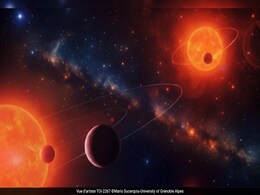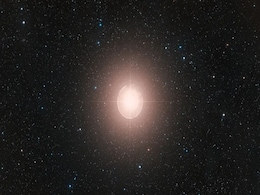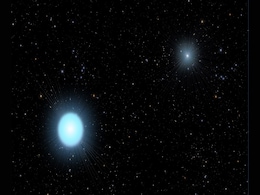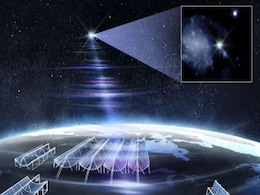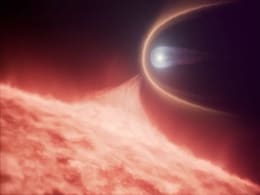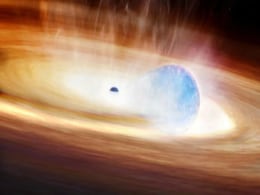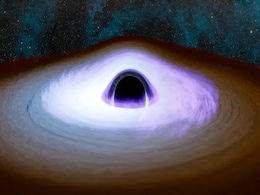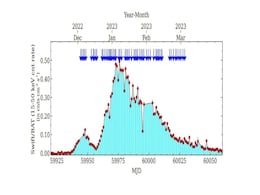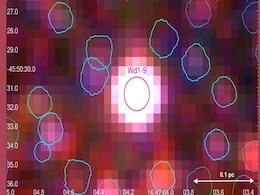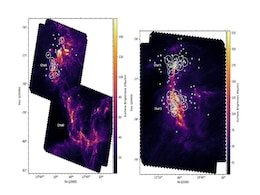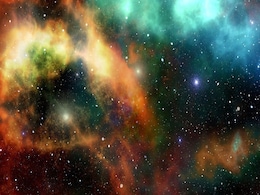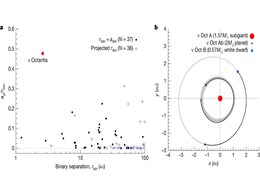Binary Star
- All
- News
- Videos
-

Astronomers Stunned By Three Earth-Sized Planets In Distant Unique Planetary System
- Wednesday October 29, 2025
- Science |
The study revealed that TOI-2267 has two closely bound stars orbiting each other, and the third planet transits the companion star.
-
 www.ndtv.com
www.ndtv.com
-

NASA Telescopes Capture First-Ever Companion Star Orbiting Massive Red Supergiant Betelgeuse
- Sunday October 26, 2025
Astronomers have detected a small companion star orbiting the red supergiant Betelgeuse using Hubble and Chandra observations. Dubbed “Betelbuddy,” the discovery reveals an extreme binary system that challenges existing models of stellar evolution and may offer clues to Betelgeuse’s future.
-
 www.gadgets360.com
www.gadgets360.com
-

NASA Hubble Space Telescope Uncovers One of the Youngest Known Blue Straggler–White Dwarf Systems
- Thursday September 11, 2025
Italian astronomers using the Hubble Space Telescope have discovered a white dwarf orbiting a blue straggler star in the globular cluster 47 Tucanae, located 15,300 light-years away. The rare system, among the youngest detected, sheds light on stellar mass transfer and offers vital clues to the evolution of binary stars in dense clusters.
-
 www.gadgets360.com
www.gadgets360.com
-

Astronomers Detect RBFLOAT, Brightest Fast Radio Burst Ever Observed
- Monday August 25, 2025
An international team of astronomers has detected RBFLOAT, the brightest fast radio burst (FRB) ever recorded, just 130 million light-years away in Ursa Major. Detected by CHIME in March 2025, the powerful radio flash was traced to galaxy NGC-4141. Follow-up imaging with the James Webb Space Telescope revealed a faint stellar source near the burst,...
-
 www.gadgets360.com
www.gadgets360.com
-

Hubble Discovers White Dwarf Merger Remnant with Unusual Carbon Signature
- Friday August 22, 2025
An international team of astronomers has discovered WD 0525+526, an unusual white dwarf about 128 light-years away, using NASA’s Hubble Space Telescope. Unlike typical white dwarfs, this star formed through a stellar merger and shows an unexpectedly high carbon content. With a mass of 1.2 Suns and a scorching surface temperature of 21,000 K, the ...
-
 www.gadgets360.com
www.gadgets360.com
-

Astronomers Observe Rare Supernova–Black Hole Interaction in Early Stages
- Sunday August 17, 2025
In a groundbreaking discovery, astronomers observed SN 2023zkd, a supernova that may have been triggered by close interaction with a black hole. Featuring unusual brightness peaks and extended pre-explosion activity, the event offers new insights into star black hole dynamics. Real-time AI detection played a key role, and upcoming surveys promise t...
-
 www.gadgets360.com
www.gadgets360.com
-

NASA’s IXPE Challenges Theories on Black Hole Corona and Polarised X-Ray Emissions
- Saturday August 16, 2025
NASA’s Imaging X-ray Polarimetry Explorer (IXPE) has made surprising observations in a black hole binary system, detecting a high degree of X-ray polarisation that challenges current models of corona structure and accretion discs. In X-ray binaries, black holes pull matter from nearby stars, forming hot accretion discs and coronas.
-
 www.gadgets360.com
www.gadgets360.com
-

James Webb Telescope Detects Potential Gas Giant Exoplanet Just 4 Light-Years Away
- Friday August 8, 2025
Astronomers using JWST have spotted a possible gas giant orbiting Alpha Centauri A, only 4 light-years away. If confirmed, it would be the closest exoplanet to a Sun-like star ever imaged. The discovery could challenge current models of planetary formation in binary systems and open new opportunities for studying nearby worlds.
-
 www.gadgets360.com
www.gadgets360.com
-

Chinese Astronomers Use Insight-HXMT to Decode X-ray Outburst of Binary Star System
- Tuesday August 5, 2025
In a recent study published on July 24 via arXiv, astronomers from Wuhan University have detailed the powerful X-ray outburst of the Be/X-ray binary system RX J0440.9+4431. Using China’s Insight-HXMT satellite, the team tracked the event from its eruption in December 2022 through March 2023.
-
 www.gadgets360.com
www.gadgets360.com
-

Supergiant Star Wd1-9 Investigated: Know Everything about New Findings and Insights from Supergiant Star
- Saturday August 2, 2025
The supergiant star called Wd1-9 has been recently investigated in detail. This detailed, in-depth research was done using NASA’s Chandra X-Ray Observatory. The new findings suggest that it is a part of the binary system.
-
 www.gadgets360.com
www.gadgets360.com
-

Radio Observations in Chamaeleon Cloud Reveal Five Young Stars, Including a Binary System
- Thursday July 3, 2025
A team of astronomers using the Australia Telescope Compact Array (ATCA) discovered five young stars in the Chamaeleon cloud complex. One is a probable tight binary system. These findings enhance our understanding of early stellar evolution and the structure of southern star-forming regions.
-
 www.gadgets360.com
www.gadgets360.com
-

Radio Signal from Early Universe May Reveal the Masses of the First Stars
- Sunday June 22, 2025
A newly modelled 21-centimetre radio signal from hydrogen atoms just 100 million years after the Big Bang may reveal the mass of the universe’s first stars. Using REACH and the upcoming SKA telescopes, researchers aim to uncover how early starlight shaped cosmic evolution during the Cosmic Dawn, when the universe transitioned from darkness to lig...
-
 www.gadgets360.com
www.gadgets360.com
-

Strange Planet Confirmed in Binary Star System Nu Octantis
- Wednesday May 28, 2025
Astronomers have confirmed the existence of a massive planet in the Nu Octantis binary star system, first suspected in 2004. Using advanced tools like the HARPS spectrograph, researchers found that the planet orbits in the opposite direction of one of the stars—a retrograde motion that keeps the system stable. The discovery of a white dwarf in th...
-
 www.gadgets360.com
www.gadgets360.com
-

Bizzare 'Failed Star' Planet Orbiting Double Star System in Milky Way Discovered by Researchers
- Thursday April 17, 2025
Astronomers have discovered an exoplanet 90 degrees tilted around a special pair of eclipsing brown dwarfs. This uncommon "polar planet" challenges accepted wisdom on planet creation by presenting new insights on the dynamics of binary stars and the range of Milky Way planetary orbits.
-
 www.gadgets360.com
www.gadgets360.com
-

T Corona Borealis May Erupt Soon: Rare Nova Could Be Visible to Naked Eye
- Tuesday April 1, 2025
T Corona Borealis, a binary star system in the Northern Crown constellation, is showing signs of an imminent nova eruption. The white dwarf star, which pulls material from its red giant companion, last erupted in 1946. Astronomers have detected patterns similar to previous eruptions, leading to predictions of a possible outburst within the next two...
-
 www.gadgets360.com
www.gadgets360.com
-

Astronomers Stunned By Three Earth-Sized Planets In Distant Unique Planetary System
- Wednesday October 29, 2025
- Science |
The study revealed that TOI-2267 has two closely bound stars orbiting each other, and the third planet transits the companion star.
-
 www.ndtv.com
www.ndtv.com
-

NASA Telescopes Capture First-Ever Companion Star Orbiting Massive Red Supergiant Betelgeuse
- Sunday October 26, 2025
Astronomers have detected a small companion star orbiting the red supergiant Betelgeuse using Hubble and Chandra observations. Dubbed “Betelbuddy,” the discovery reveals an extreme binary system that challenges existing models of stellar evolution and may offer clues to Betelgeuse’s future.
-
 www.gadgets360.com
www.gadgets360.com
-

NASA Hubble Space Telescope Uncovers One of the Youngest Known Blue Straggler–White Dwarf Systems
- Thursday September 11, 2025
Italian astronomers using the Hubble Space Telescope have discovered a white dwarf orbiting a blue straggler star in the globular cluster 47 Tucanae, located 15,300 light-years away. The rare system, among the youngest detected, sheds light on stellar mass transfer and offers vital clues to the evolution of binary stars in dense clusters.
-
 www.gadgets360.com
www.gadgets360.com
-

Astronomers Detect RBFLOAT, Brightest Fast Radio Burst Ever Observed
- Monday August 25, 2025
An international team of astronomers has detected RBFLOAT, the brightest fast radio burst (FRB) ever recorded, just 130 million light-years away in Ursa Major. Detected by CHIME in March 2025, the powerful radio flash was traced to galaxy NGC-4141. Follow-up imaging with the James Webb Space Telescope revealed a faint stellar source near the burst,...
-
 www.gadgets360.com
www.gadgets360.com
-

Hubble Discovers White Dwarf Merger Remnant with Unusual Carbon Signature
- Friday August 22, 2025
An international team of astronomers has discovered WD 0525+526, an unusual white dwarf about 128 light-years away, using NASA’s Hubble Space Telescope. Unlike typical white dwarfs, this star formed through a stellar merger and shows an unexpectedly high carbon content. With a mass of 1.2 Suns and a scorching surface temperature of 21,000 K, the ...
-
 www.gadgets360.com
www.gadgets360.com
-

Astronomers Observe Rare Supernova–Black Hole Interaction in Early Stages
- Sunday August 17, 2025
In a groundbreaking discovery, astronomers observed SN 2023zkd, a supernova that may have been triggered by close interaction with a black hole. Featuring unusual brightness peaks and extended pre-explosion activity, the event offers new insights into star black hole dynamics. Real-time AI detection played a key role, and upcoming surveys promise t...
-
 www.gadgets360.com
www.gadgets360.com
-

NASA’s IXPE Challenges Theories on Black Hole Corona and Polarised X-Ray Emissions
- Saturday August 16, 2025
NASA’s Imaging X-ray Polarimetry Explorer (IXPE) has made surprising observations in a black hole binary system, detecting a high degree of X-ray polarisation that challenges current models of corona structure and accretion discs. In X-ray binaries, black holes pull matter from nearby stars, forming hot accretion discs and coronas.
-
 www.gadgets360.com
www.gadgets360.com
-

James Webb Telescope Detects Potential Gas Giant Exoplanet Just 4 Light-Years Away
- Friday August 8, 2025
Astronomers using JWST have spotted a possible gas giant orbiting Alpha Centauri A, only 4 light-years away. If confirmed, it would be the closest exoplanet to a Sun-like star ever imaged. The discovery could challenge current models of planetary formation in binary systems and open new opportunities for studying nearby worlds.
-
 www.gadgets360.com
www.gadgets360.com
-

Chinese Astronomers Use Insight-HXMT to Decode X-ray Outburst of Binary Star System
- Tuesday August 5, 2025
In a recent study published on July 24 via arXiv, astronomers from Wuhan University have detailed the powerful X-ray outburst of the Be/X-ray binary system RX J0440.9+4431. Using China’s Insight-HXMT satellite, the team tracked the event from its eruption in December 2022 through March 2023.
-
 www.gadgets360.com
www.gadgets360.com
-

Supergiant Star Wd1-9 Investigated: Know Everything about New Findings and Insights from Supergiant Star
- Saturday August 2, 2025
The supergiant star called Wd1-9 has been recently investigated in detail. This detailed, in-depth research was done using NASA’s Chandra X-Ray Observatory. The new findings suggest that it is a part of the binary system.
-
 www.gadgets360.com
www.gadgets360.com
-

Radio Observations in Chamaeleon Cloud Reveal Five Young Stars, Including a Binary System
- Thursday July 3, 2025
A team of astronomers using the Australia Telescope Compact Array (ATCA) discovered five young stars in the Chamaeleon cloud complex. One is a probable tight binary system. These findings enhance our understanding of early stellar evolution and the structure of southern star-forming regions.
-
 www.gadgets360.com
www.gadgets360.com
-

Radio Signal from Early Universe May Reveal the Masses of the First Stars
- Sunday June 22, 2025
A newly modelled 21-centimetre radio signal from hydrogen atoms just 100 million years after the Big Bang may reveal the mass of the universe’s first stars. Using REACH and the upcoming SKA telescopes, researchers aim to uncover how early starlight shaped cosmic evolution during the Cosmic Dawn, when the universe transitioned from darkness to lig...
-
 www.gadgets360.com
www.gadgets360.com
-

Strange Planet Confirmed in Binary Star System Nu Octantis
- Wednesday May 28, 2025
Astronomers have confirmed the existence of a massive planet in the Nu Octantis binary star system, first suspected in 2004. Using advanced tools like the HARPS spectrograph, researchers found that the planet orbits in the opposite direction of one of the stars—a retrograde motion that keeps the system stable. The discovery of a white dwarf in th...
-
 www.gadgets360.com
www.gadgets360.com
-

Bizzare 'Failed Star' Planet Orbiting Double Star System in Milky Way Discovered by Researchers
- Thursday April 17, 2025
Astronomers have discovered an exoplanet 90 degrees tilted around a special pair of eclipsing brown dwarfs. This uncommon "polar planet" challenges accepted wisdom on planet creation by presenting new insights on the dynamics of binary stars and the range of Milky Way planetary orbits.
-
 www.gadgets360.com
www.gadgets360.com
-

T Corona Borealis May Erupt Soon: Rare Nova Could Be Visible to Naked Eye
- Tuesday April 1, 2025
T Corona Borealis, a binary star system in the Northern Crown constellation, is showing signs of an imminent nova eruption. The white dwarf star, which pulls material from its red giant companion, last erupted in 1946. Astronomers have detected patterns similar to previous eruptions, leading to predictions of a possible outburst within the next two...
-
 www.gadgets360.com
www.gadgets360.com

